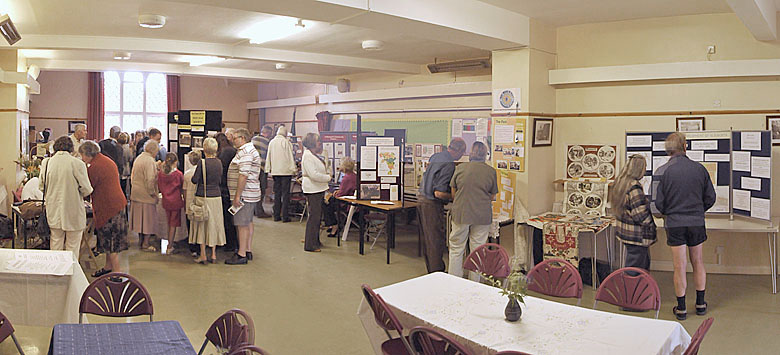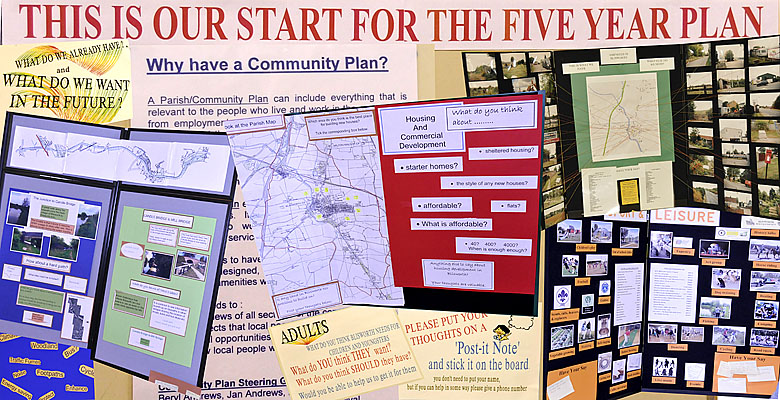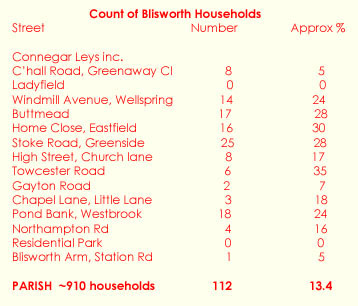|
Blisworth Community Plan aka. the Parish Plan September 2009 to some time in 2011 To cut to the chase - scroll or click here The village is generally thought to display much apathy since past discussions upon community affairs have been difficult to get going. Neighbouring villages have enjoyed varying success with a village plan, or a community plan, in response to urging from the local government. They have pointed out that it will be worth doing because parish council and SNC are obliged to listen and expected to take action in the simpler of issues. The village has been approaching The Plan this year (2009) in three stages, a village awareness day "Blisworth Past and Present" staged in the village hall on September 5th by the Heritage Society, a "Come and Have Your Say" Day also in the village hall on two days (October 10th and 11th) and, a few weeks later, there will be the circulation of a large questionnaire to all households from which some quantification could be obtained for the relative importance of issues. An important aspect of the plan is that it sets the scene for community management for five years - leaving some of us hoping the parish council can adapt to the challenge. The
September meeting emphasised village history and the role of various
societies and provided an early warning and justification for the
October sessions. It
was reasonably well attended. The October meeting was particularly well prepared in that all households were given a leaflet about the meeting a few days prior. In the village hall the preparations involved the setting up of seven displays. These were on 1. housing development, 2. general amenities, 3. sport and leisure, 4. youth facilities, 5. canal partnership projects, 6. the environment including conservation and 7. traffic and transport issues. The array in the hall was too difficult to photograph 'in one' - hence the suggestive composite which follows.
The
displays
were aimed to draw attention to specific issues and invite comment - most
of the issues were in a context of 'let's improve the village'.
Comments from all quarters were collected as 'Post-It' notes which were
either put on display or placed in an anonymous box. Some displays
were designed so that ticks may be placed into a choice of boxes.
In one way or another, views were sampled. For every arrival at
the hall, the
location of their house was logged using red dots on a map of the
parish. This revealed total numbers of households represented and
in which streets they were distributed and here are the results of that
breakdown. Nevertheless, a participation rate of over 20% for half the streets is at least a mildly encouraging outcome and, if a similar response is obtained for the questionnaires, we will be able to assume the results were a useful indication of village opinion. The neighbouring village of Roade received a return rate of over 40% for their questionnaires. At the end of the two day session the comments were sorted so that issues could be graded in respect of their importance to villagers. There were put up 100s of "Post-It" notes which go forward in an analysis that helped design questions to be included in the questionnaire which was distributed to 800 households early in 2010 (not all houses could be sampled). The Return of the Survey Questionnaires By March 2010, the return of the questionnaire at Blisworth amounted to 75% - a truly amazing figure especially in view of the fact that SNC distributed in November 2009 an opinion questionnaire that overlapped the subject matter of ours! Slivers of statistical snippets have been disclosed occasionally, eg. in the Chronicle & Echo and at the monthly Parish Council meetings. Further reporting on the topics will await the availability of a complete report which is expected on October 17th at a gathering in the Village Hall. The project has in the meantime been renamed Community Action Plan on account of the fact that actions have already taken place as a result of some of the findings in the survey, for example: the PC are responding favourably to the criticism about poor communications and that planning matters have been sometimes dealt with in a dilatory way, traffic surveys and speed-monitor vans are deployed (though NHW were doing that anyway) and a few new leisure groups are being established during the summer. The Complete Report of the Survey October 17th, 2010. Jan and Alan Andrews were responsible for setting up this project in the first place and Jane Percival has helped with useful input at times. Aside from these people, the main task was taken on by, in alphabetical order, Beryl Andrews, Di Burgoyne, Margarete Field, Mason and Pat Masterman, Ann North, Linda Pusey and Sarah Sykes. Along with the release of a limited quantity of survey documents that were filled with over 50 bar charts - just the bare results - there were a number of display boards with reproductions of many bar charts coupled with text that either explained them or pointed out some of the more obvious conclusions. Towards the end of the year there will be published the group's Community Management Plan, the "CMP", that will set out suggested improvements for the next five years. The CMP will be sent to the parish council, the SNC and the NCC for discussion and an Executive Summary will be posted to all parish households - possibly with the Round and About magazine. Since writing this account, the publication date for the CMP was revised for January 2011 and then postponed again till end-April ("Easter"), 2011 - a total elapsed time after acquisition of some of the data (October 2009) of 19 months: Why? Clearly it is the CMP that we need to look at - or at least its Executive Summary. In the meantime here are some conclusions drawn from a careful examination of the survey data - it will be interesting to see how much more penetrative the final plan proves to be. "CMP" is subject to a moratorium; terminology has reared its head in February 2011 - it is thought inappropriate to describe the output from the group who is working on the survey as a "community plan". It is to be named the "Parish Plan" instead. Arising from the survey and the parish plan, when we can read it, may be an action to generate a "Village Design Statement" (VDS), being a document that expresses the future desirable "state" of the village, against which future planning applications may be judged. So we need to get on, as a community, and write that VDS. The PC had adopted a 12 month cycle for the development of this document having, in March 2011, received the draft of a very short-and-sweet version. Apparently as there is little development wanted for Blisworth, little space is needed to say so. By October 2011 however, the details of the Localism Bill passing through Parliament had changed the goal posts rather dramatically - it is a Neighbourhood Plan that we must now attend to. This is covered in a separate article first posted on this site in November 2011. The Parish Plan was distributed in early April 2011 and, without fear of exaggeration, it appears to be a very weak document and hardly a plan at all. It is not a plan though it is labelled addressing the period 2011 - 2016. However the latest scheduled attainment was for 2013 and merely dealt with an aspect of how the PC could better communicate with the village. Most "actions", that were implied to be the result of the survey (though one must question that), were reported to be ongoing - until done, presumably. All of that is of course good news for the health of the village - self-improvement is ongoing. But otherwise, what a waste of effort. The reader's attention is drawn to the link two paragraphs earlier. |


